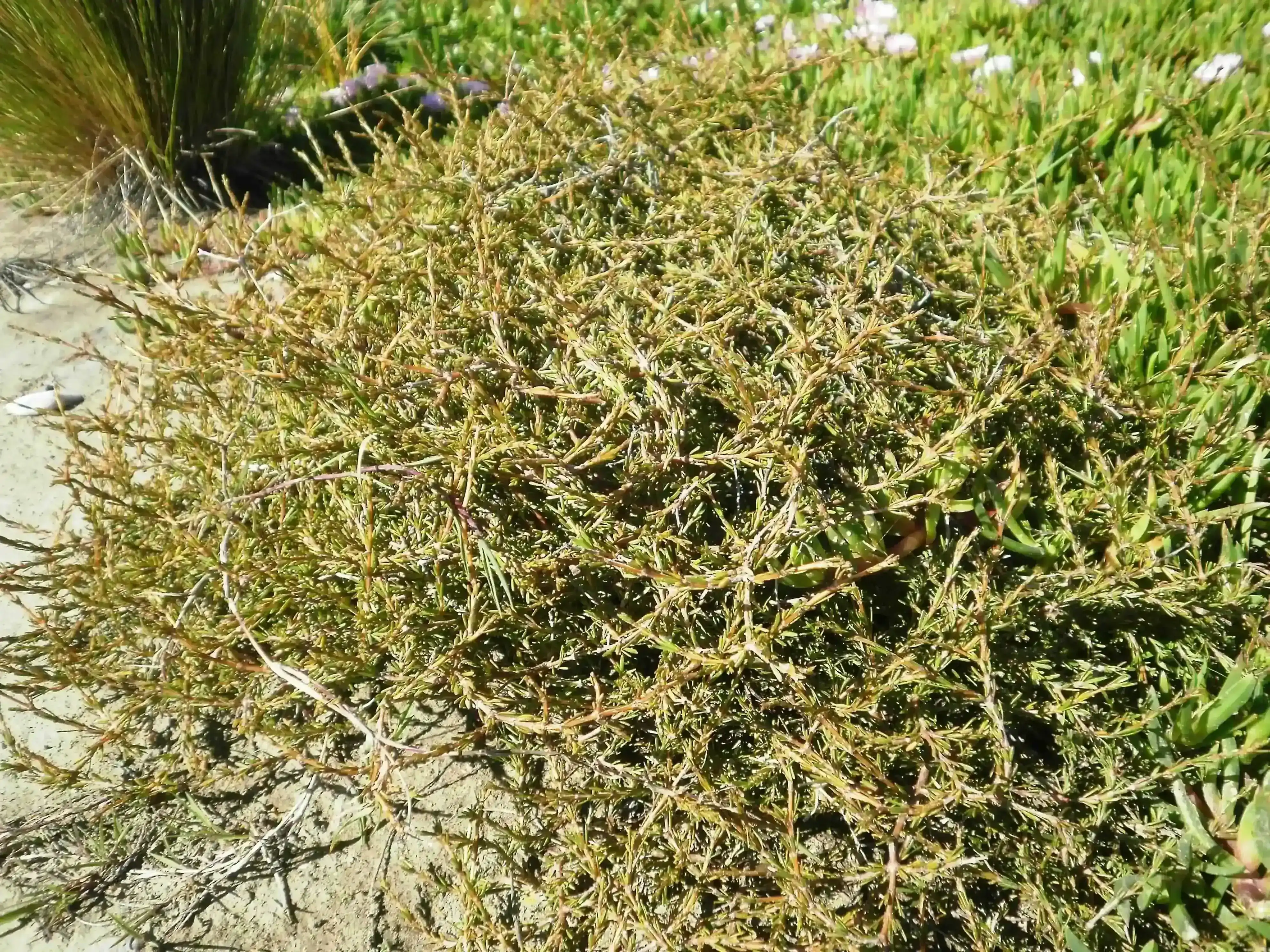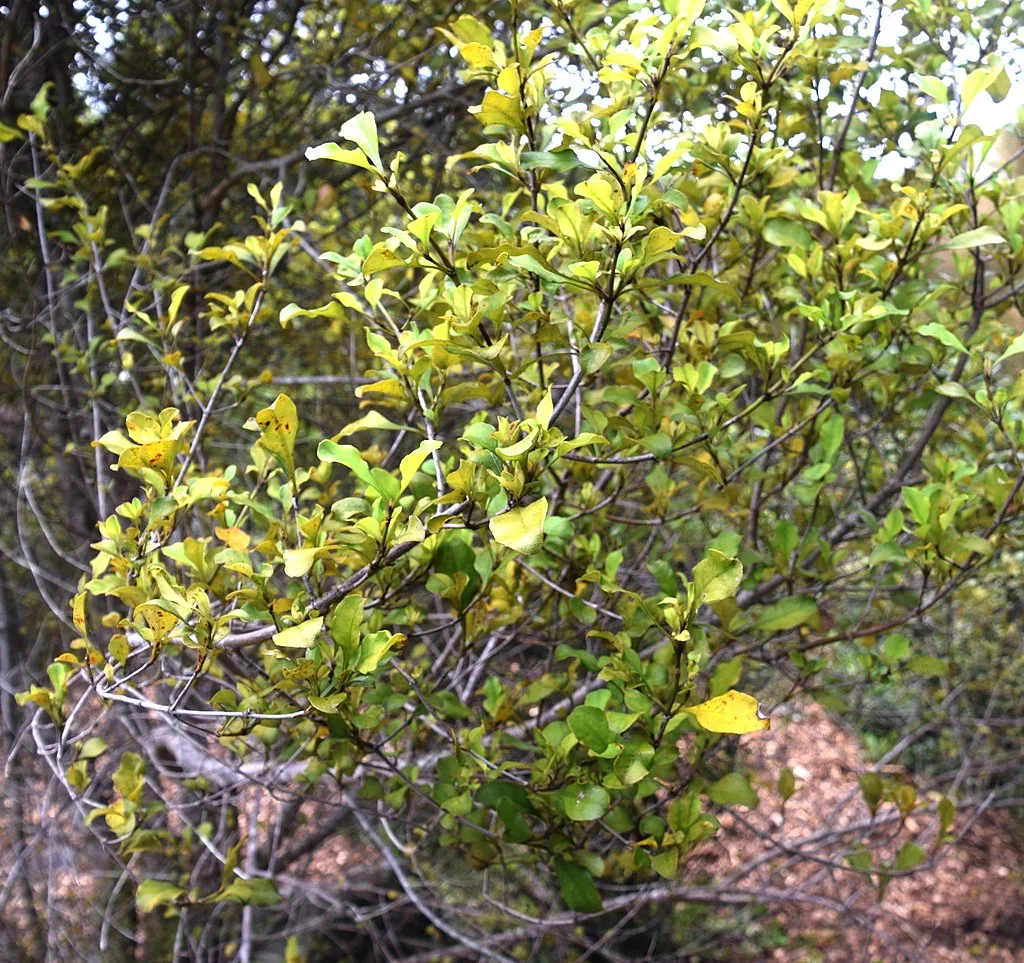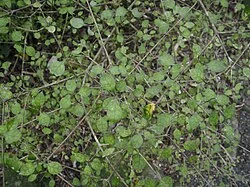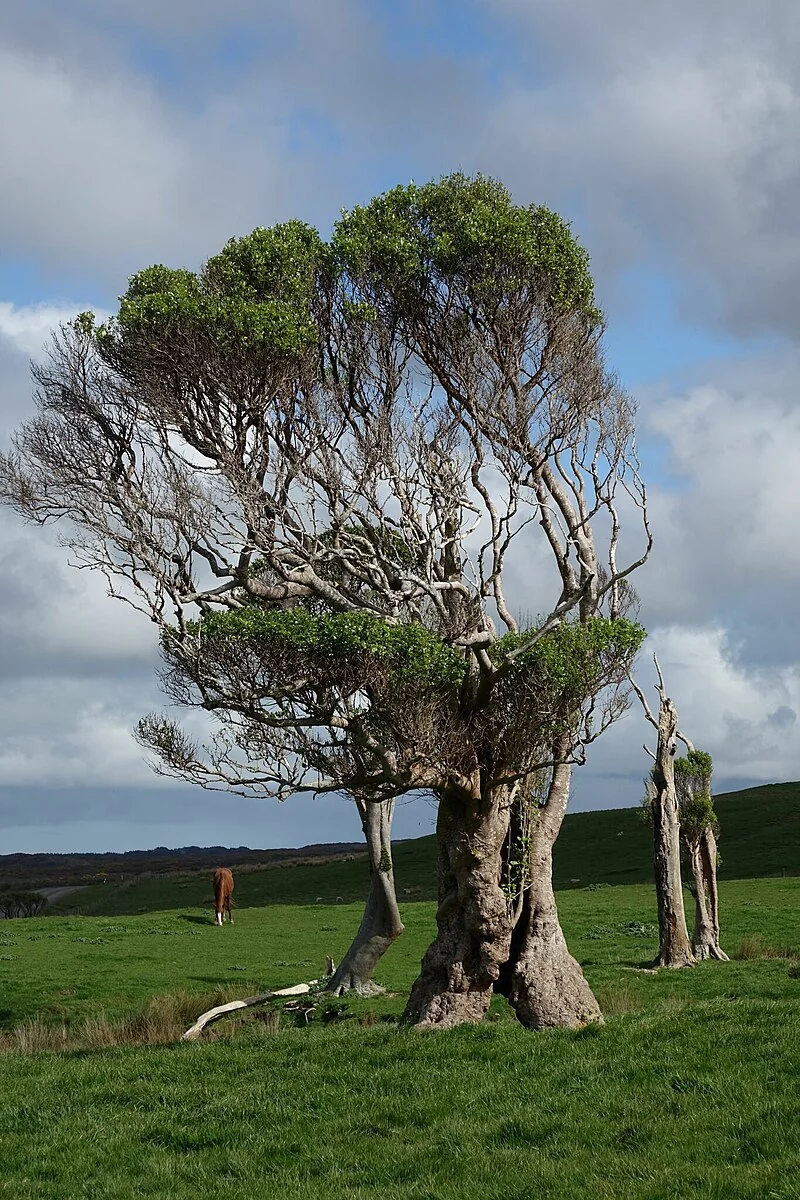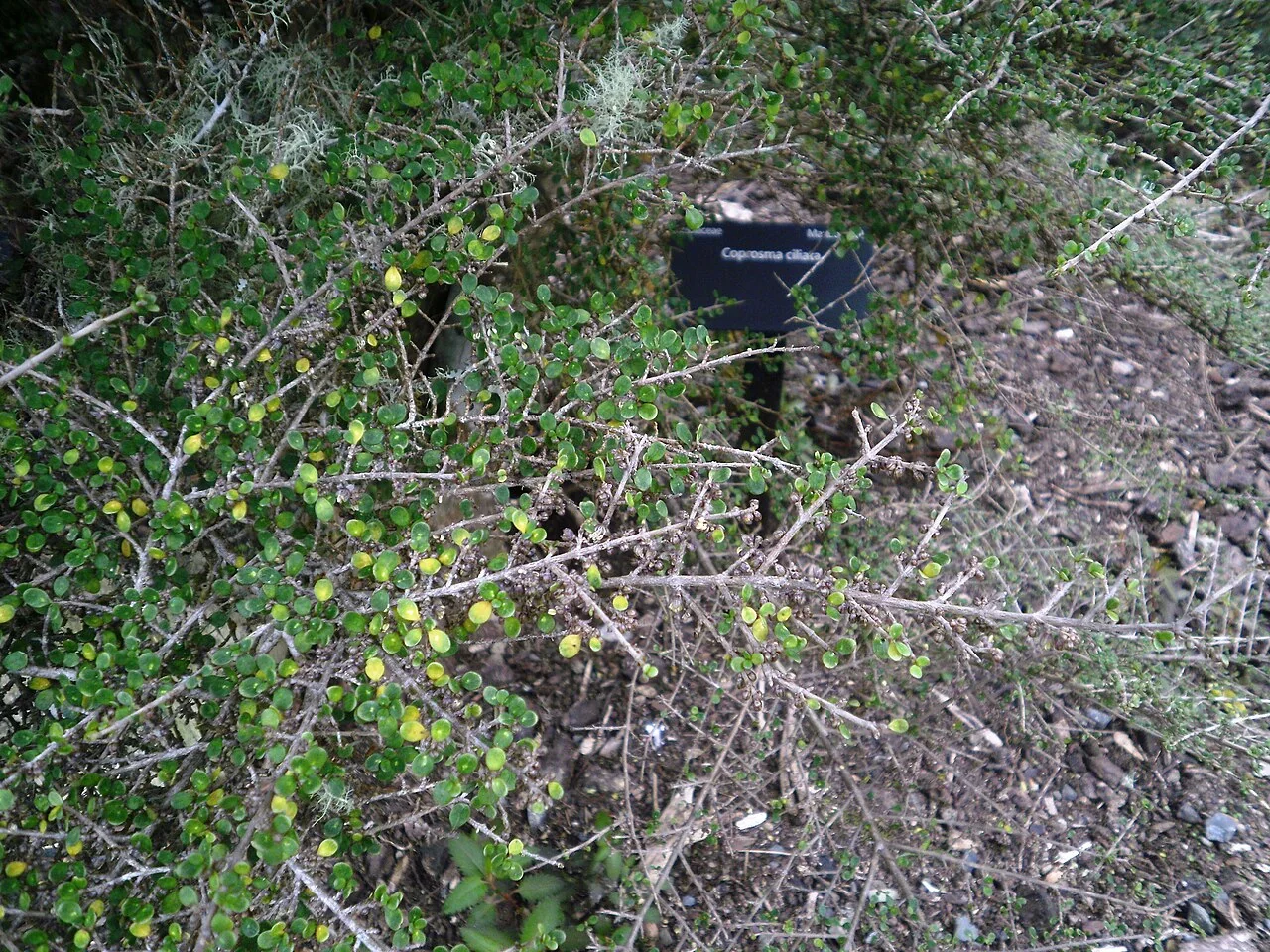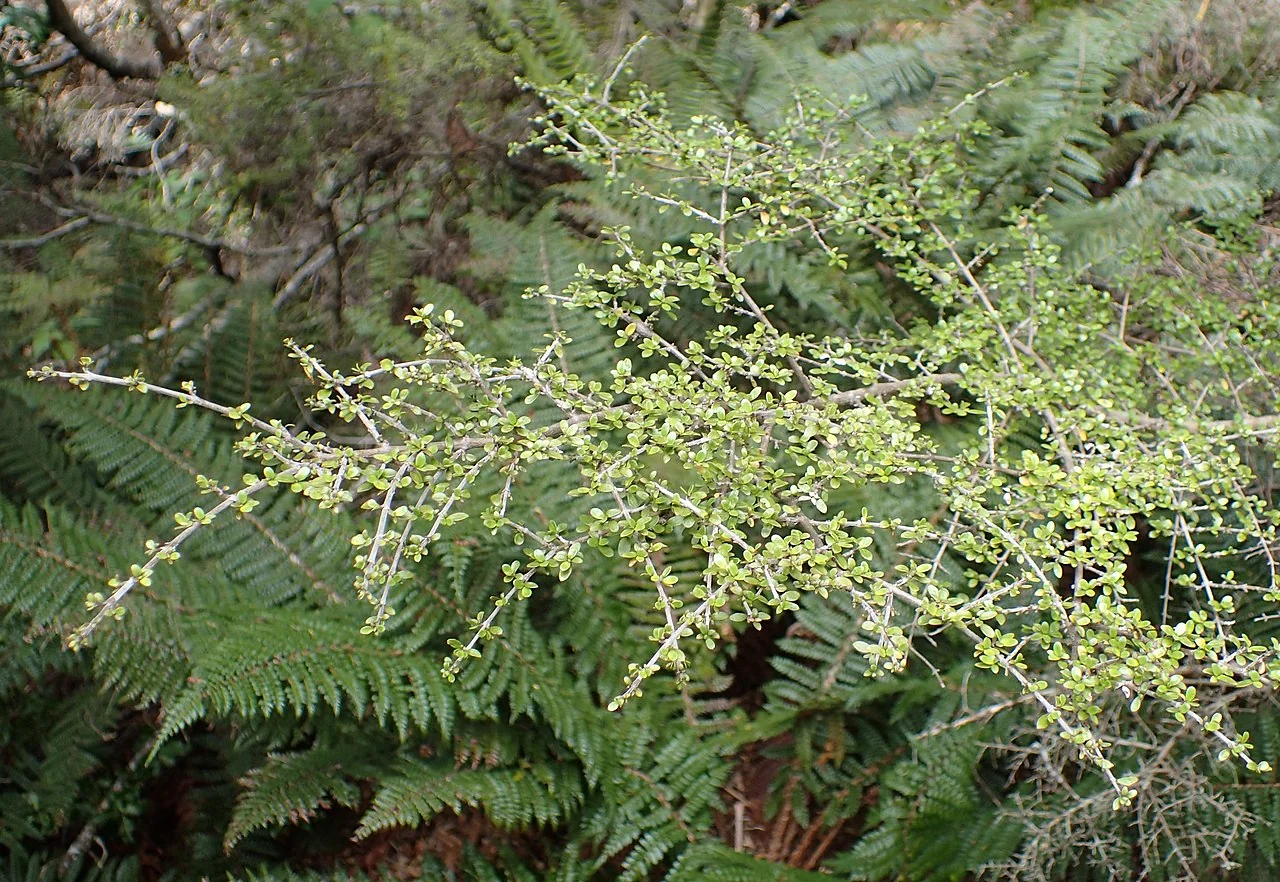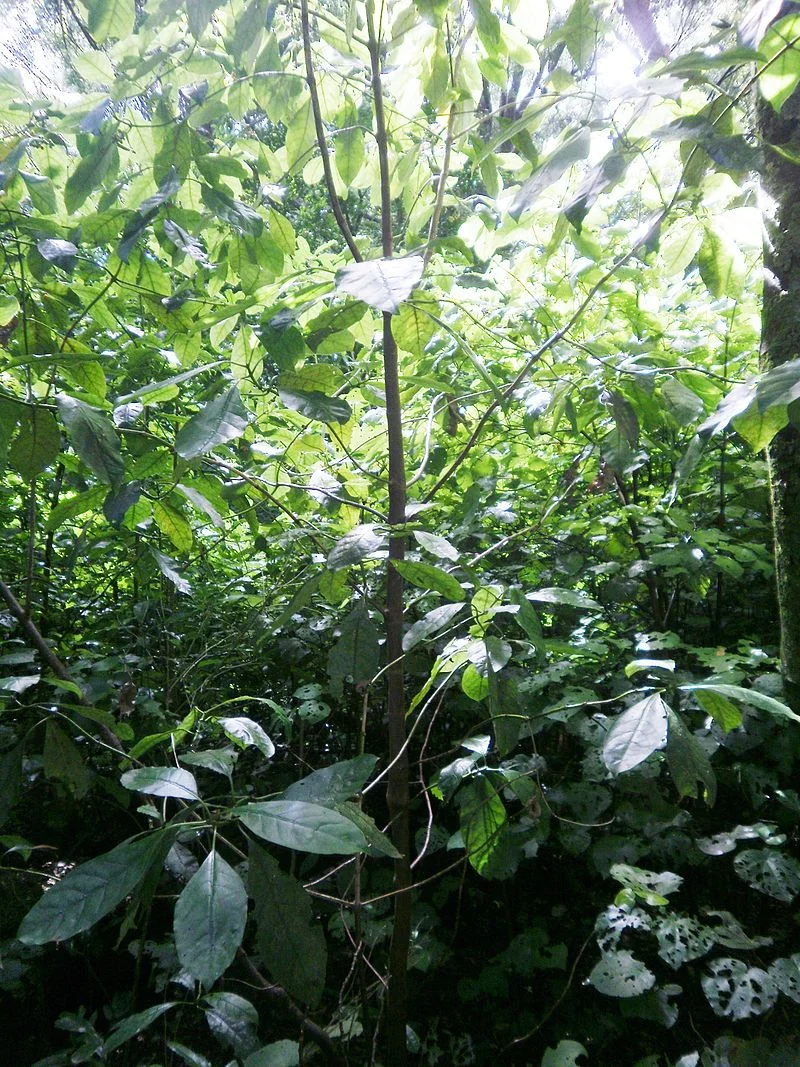
Kanono
Coprosma grandifolia
Coprosma grandifolia , also known by its common names kanono, large-leaved coprosma, and raurekau, is an evergreen shrub among New Zealand's native shrubs or small tree native to New Zealand. It can grow up to 6 meters tall, often branching from the base or having a single trunk. The leaves are large, typically 100-300 mm long and 50-100 mm wide, broadly elliptic to obovate. They are pale green and often mottled with darker green, maroon, or purple, with prominent venation and small pits (domatia) on the underside where lateral veins meet the midrib. The flowers are small, green or white, borne in clusters on branched stalks. The fruit is a reddish-orange, oblong drupes, 7-9 mm long, appearing in open clusters on obvious stalks. Coprosma grandifolia is endemic to New Zealand, found in both the North and South Islands. It commonly grows in the understory of forests and in sheltered, shady sites from coastal to montane and cloud forest areas.

Plant Description
Botanical Features
Coprosma grandifolia , also known as Kanono, or Large-leaved Coprosma, is an evergreen shrub or small tree endemic to New Zealand. It can grow up to 6 meters tall, often branching from the base or having a single trunk. It is easily recognized by its large, broad, pale green, and often mottled leaves, typically 10-30 cm long, with prominent venation and small pits (domatia) on the underside. The flowers are small, green or white, borne in clusters, and are followed by reddish-orange, oblong drupes (berries) that are 7-9 mm long, appearing in open clusters. It is found in the understory of forests and in sheltered, shady sites from coastal to montane and cloud forest areas throughout both the North and South Islands.
Quick Facts
| Scientific Name | Coprosma Grandifolia |
|---|---|
| Height | 3-6 m |
| Spread | 2-4 m |
| Water Needs | Moderate |
| Light | Part shade to full sun |
| Frost Tolerance | Moderate |
| Salt Tolerance | Good |
| Growth Rate | Moderate |
| Lifespan | Long |
Climate Best Suited to
White maire (Nestegis lanceolata) is primarily found in lowland to hilly forests across the North Island of New Zealand, extending to the Marlborough Sounds in the South Island. It demonstrates good adaptability to various conditions, thriving in areas with well-drained soils and tolerating both full sun and partial shade. Its natural distribution suggests a preference for warmer, more humid environments but with a reasonable tolerance for cooler temperatures found in its southern range.
Regional Suitability
| Whangārei | Ideal |
| Auckland | Ideal |
| Hamilton | Suitable |
| Rotorua | Suitable |
| Tauranga | Ideal |
| Gisborne | Ideal |
| New Plymouth | Ideal |
| Whanganui | Ideal |
| Palmerston North | Suitable |
| Napier | Ideal |
| Wellington | Ideal |
| Nelson | Ideal |
| Christchurch | Suitable |
| Dunedin | Suitable |
| Invercargill | Suitable |
| City | Climate Suitability |
|---|
Natural Habitat
Kanono ( Coprosma grandifolia ) is a versatile species found throughout the North and South Islands of New Zealand, thriving in a variety of sheltered, moist environments. It is a common understorey shrub or small tree in lowland to montane forests, often favouring shady gullies, stream banks, and forest margins where the soil is consistently damp but well-drained. Its natural range extends from coastal forests right up to the cloud forests at higher altitudes (up to 1000 meters), demonstrating its adaptability to different light levels and temperature ranges. While it prefers the dappled light of the forest floor, it can also be found in more open, disturbed areas such as along the edges of tracks and roads, particularly in regions with high rainfall. This adaptability makes it a resilient and widespread component of New Zealand's native ecosystems.
Plant Conservation
Coprosma grandifolia , also known as kanono or large-leaved coprosma, is classified as "Not Threatened" in New Zealand. This conservation status applies nationally, and regionally in areas like Auckland, it is also considered Regionally Not Threatened.
Growing Requirements
Soil Requirements
White maire (Nestegis lanceolata) is remarkably adaptable to different soil conditions, thriving in well-drained environments. It can tolerate a variety of soil types, from sandy to loamy, and prefers a neutral to slightly acidic pH. Good drainage is crucial to prevent root rot, ensuring healthy growth and development.
- Tolerates a wide range of soil types from clay to sandy
- Prefers well-draining soils but can handle occasional waterlogging
- Thrives in moderately fertile soils but will grow in poor soils too
- Can tolerate slightly acidic to slightly alkaline pH
- Handles coastal conditions including salt spray
Light Requirements
White maire (Nestegis lanceolata) thrives in a variety of light conditions, from full sun to partial shade. Optimal growth and flowering are typically achieved in locations receiving ample sunlight throughout the day. However, it can also tolerate some shade, especially in hotter climates, where it benefits from protection during the most intense afternoon sun.
- Full sun for optimal growth and form
- Can tolerate partial shade but may develop a leggier form
- At least 6 hours of direct sunlight daily is ideal
- Northern or eastern exposures work well in garden settings
Water Requirements
Once established, White maire (Nestegis lanceolata) is remarkably drought-tolerant, requiring minimal supplemental watering. During its establishment phase, consistent moisture is crucial to encourage strong root development. Mature plants can withstand dry periods, but regular watering during prolonged droughts will promote healthier growth and more abundant flowering.
- Moderate watering during establishment (first 1-2 years)
- Drought-tolerant once established
- Can handle periods of soil saturation
- Reduce watering in winter when growth slows
- Signs of overwatering include yellowing leaves and crown rot
Planting Guide
When to Plant
Plant Coprosma grandifolia from spring through autumn when soil conditions are suitable.
Site Selection and Soil
- Light: Prefers light shade to partial sun, though it can tolerate full sun if moisture is maintained. The darkest leaf colouring occurs in full sun, but it may grow less densely in partial shade.
- Soil: Thrives in moist, very well-drained, neutral to slightly acidic soil. It can succeed in most soil types but avoids waterlogged conditions. For optimal growth, free-draining, humus-rich loams are recommended.
- Exposure: It is wind-tolerant, but shelter can improve leaf quality. It's also tolerant of coastal environments.
- Space: Ensure enough space for its mature size, which can be up to 8 meters tall and 5 meters wide.
Planting Steps
- Dig a hole twice the depth and width of the plant's root ball.
- Mix compost (e.g., Kings Compost) and sheep pellets into your existing soil at a 50/50 ratio.
- Backfill the hole so that the top of the plant's roots are level with the surrounding ground.
- In heavy clay soils with drainage issues, plant onto a raised mound and add gypsum clay breaker to the bottom of the hole to help condition the soil.
- Water in well with an organic garden booster.
After Planting Care
Water deeply after planting to settle the soil around the roots. Keep the soil moist for several weeks until the plant establishes. Once established, it has moderate drought tolerance but performs better with consistent soil moisture during the growing season. Mulching can help retain soil moisture.
Ecological Role
Environmental Benefits
Coprosma grandifolia , also known as kanono or large-leaved coprosma, plays several important ecological roles in New Zealand's native ecosystems.
- Habitat and Food Source: The plant provides habitat and its reddish-orange, oblong drupes serve as a food source for native birds and reptiles, aiding in seed dispersal.
- Ecosystem Support: It is a significant component of the forest understory, particularly in sheltered and shady locations, and contributes to the overall health and biodiversity of native plant communities. In areas with high rainfall, it can form a major part of shrublands and regenerating forests.
- Mutualistic Relationships: The leaves of Coprosma grandifolia feature distinctive indentations called domatia. These domatia offer a safe refuge for predatory insects, which then help protect the plant by preying on herbivorous insects. This interaction demonstrates a mutualistic relationship where both the plant and the predatory bugs benefit.
- Host Plant: It can act as a host plant for native mistletoe species, such as Ileostylus micranthus.
Uses and Significance
Garden Uses
- Specimen tree for visual impact
- Suitable for native gardens and restoration projects
- Enhances native garden aesthetics and biodiversity
- Provides architectural accent with its unique structure
- Effective for erosion control on slopes and banks
Ecological Value
Ecologically, White maire (Nestegis lanceolata) plays a crucial role in supporting native ecosystems. Its fruits are a food source for birds, especially the kererū, contributing to the local biodiversity and food web.
- Provides a vital food source for native birds, especially the kererū
- Offers habitat and nesting sites for various fauna
- Contributes to soil stabilization and nutrient cycling
- Forms natural shelter belts, protecting other species
Cultural Significance
Traditional Uses and Values
Coprosma grandifolia , known as kanono or raurekau in Māori, holds significant cultural importance in Aotearoa (New Zealand).
- Dye Source: The bark of Coprosma grandifolia was highly valued by Māori for producing a vibrant orange or yellow dye. This dye was used in traditional crafts and for ceremonial items, particularly for dyeing flax fibers. The colour could vary depending on the mordant used, and older shrubs growing in sunny places were noted to give a deep golden colour.
- Medicinal Uses: The plant was extensively used in traditional Māori medicine. The inner bark's sap was applied to treat scabies (hakihaki). Crushed bark was used for cuts, sores, fevers, bruises, and urinary complaints. Infusions of leaves were applied to broken limbs and bruises, and a bluish-black fluid from boiled leaves and twigs was used to bathe bad cuts, festered sores, gunshot wounds, and fractures.
-
Other Uses:
- The leaves were sometimes strewn in sitting and sleeping places.
- A thin, filmy white substance detached from the leaves, called kahu raurēkau, was used by women to make a type of apron or a pohoi (a bunch of material suspended from the ear).
- The leaves were also used by fowlers as a "pepe" or call leaf.
- The fruit, though with little flavor, was eaten raw and described as sweet and juicy. The roasted seeds could also be used as a coffee substitute.
Landscaping Uses
Garden Design Applications
Coprosma grandifolia , also known as Kanono, or Large-leaved Coprosma, is a versatile New Zealand native shrub or small tree with several landscaping applications.
- Hedges and Screening: Its fast growth rate (up to 75 cm per year) and lush foliage make it excellent for creating dense screens or hedges for privacy. It can be used for both formal and informal hedges, typically growing between 1.5 and 3 meters tall.
- Mixed Plantings and Woodland Gardens: It is commonly integrated into mixed plantings and woodland gardens, providing a bold texture with its large, glossy green leaves. It thrives as an understory plant in shady to semi-shaded areas.
- Riparian and Pond Areas: It is well-suited for planting around stream and pond areas, contributing to riparian restoration efforts.
- Wildlife Attraction: The plant produces small, orange berries that ripen over a year, attracting native birds and reptiles, making it valuable for wildlife gardens and ecological restoration projects.
- Revegetation: Due to its hardiness, rapid establishment, and wildlife benefits, it is a key species in habitat restoration, particularly in forest margins and clearings.
- Coastal Forest Gardens: It is suitable for coastal forest gardens, wetlands, and water features, preferring damp, well-drained soil.
Seasonal Care Calendar
Spring
In spring, White maire (Nestegis lanceolata) begins its active growth phase. New foliage emerges, and it's an ideal time for planting new specimens or propagating. Ensure adequate moisture and monitor for early signs of pests.
- New growth begins with fresh foliage development
- Apply a balanced, slow-release fertilizer if desired
- Excellent time for planting new specimens or dividing offsets
- Monitor for new pest activity and address promptly
Summer
Summer is the peak growing season for White maire (Nestegis lanceolata), often accompanied by flowering. Consistent watering is important, especially for young plants, to support vigorous growth and prevent stress during dry periods.
- Flowering typically occurs in early to mid-summer (November-January)
- Water young trees regularly during extended dry periods
- Avoid heavy pruning during the active growing season
Autumn
During autumn, White maire (Nestegis lanceolata) prepares for the cooler months. Fruits or berries develop, providing food for native birds. It's also a good time for planting and general garden cleanup.
- Fruits or berries develop and ripen (December-February), attracting birds
- Natural leaf shedding occurs as part of its growth cycle
- Good time for planting new specimens to establish before winter
- Clean up fallen leaves if a tidy appearance is desired
Winter
Winter is generally a dormant period for White maire (Nestegis lanceolata). Minimal care is required, though young plants may benefit from protection in colder regions. This is an opportune time for any necessary structural pruning.
- Generally dormant with minimal growth activity
- No special winter protection needed in most mild climates
- Suitable time for structural pruning if required
- Fallen leaves can be left as mulch or removed for tidiness
When to Prune and How Much
White maire (Nestegis lanceolata) generally requires minimal pruning to maintain its natural form and health. Pruning should focus on removing dead or damaged growth and shaping the plant as needed.
- Remove dead, damaged, or diseased branches at any time of year
- Light formative pruning when young helps establish good structure
- To create a multi-trunked specimen, cut the main stem to encourage branching
- Fallen leaves can be removed for a tidier appearance, or left as natural mulch
- If necessary, lower branches can be removed to create clearance underneath
- Major pruning is best done in late winter to early spring before new growth
Always use clean, sharp tools for pruning to minimize the risk of disease and ensure clean cuts. The plant often responds well to pruning with vigorous new growth, contributing to a fuller, healthier appearance.
How to Grow Kanono
From Fresh Orange Berries
Fresh orange berry propagation represents the most reliable and natural method for growing Kanono, taking advantage of this large-leaved species' excellent fruit production and natural dispersal strategy that has enabled it to establish in diverse forest environments from coastal to montane elevations throughout New Zealand. This hardy endemic produces abundant reddish-orange oblong drupes in open clusters that provide exceptional opportunities for propagation while supporting the species' natural frugivory dispersal cycles essential for forest ecosystem function. The species' adaptation to forest understory conditions from coastal to cloud forests makes it particularly valuable for restoration projects and shade gardens requiring attractive native plants capable of handling variable light conditions while providing important food resources for native birds. Fresh berries yield significantly higher germination success compared to stored seeds, making immediate processing and sowing the preferred approach for both conservation propagation and garden cultivation of this ecologically important understory species. Collect ripe berries when fruits have achieved their characteristic reddish-orange coloration and can be easily removed from obvious stalks, timing collection to coincide with peak ripeness when seeds have reached maximum viability for successful establishment. Choose berries that are fully developed, firm, and show the distinctive orange coloration typical of mature fruit, avoiding any that appear damaged, diseased, or prematurely dropped which might indicate compromised seed quality. Process berries immediately after collection by macerating in water and thoroughly cleaning seeds, using gentle rubbing under running water to separate seeds from fruit pulp that could inhibit germination or promote fungal growth during establishment. Clean seeds by repeated washing until all fruit debris is removed, as the pulp can significantly inhibit germination if left in place, retaining the seeds that settle to the bottom while discarding floating material. Prepare optimal germination medium using free-draining seed-raising mix with good aeration properties, ensuring pH levels between 6.0-7.0 that support healthy development for this adaptable forest understory species. Sow fresh seeds immediately after processing, covering lightly with 2-3mm of fine sand to provide optimal conditions for germination while maintaining protection from drying out that can quickly kill developing embryos. Provide optimal environmental conditions including consistent temperatures between 15-22°C and bright light that supports germination while maintaining steady moisture without waterlogging throughout the extended germination period. Maintain careful moisture management throughout the 4-10 week germination period, as germination can be slow and irregular, requiring patience and consistent environmental conditions while monitoring for emergence signs. Keep propagation trays for extended periods to accommodate the variable germination timing characteristic of this species, ensuring optimal conditions are maintained throughout the potentially lengthy emergence window. Young seedlings develop at moderate rates while establishing the root systems necessary for adaptation to forest growing conditions, requiring prompt transplanting into tubes of sandy, gritty mix when large enough to handle. Grow seedlings in high light conditions with modest feeding regimens that support healthy development without promoting excessive soft growth vulnerable to environmental stress during forest establishment. Harden off gradually before planting into well-drained, humus-rich garden soil in sun or part shade positions that replicate the natural forest conditions where this species thrives while providing wildlife food resources.
From Semi-Hardwood Cuttings
Semi-hardwood cutting propagation offers a reliable vegetative method for growing Kanono that preserves the exact genetic characteristics of superior parent plants while providing consistent results for experienced propagators working with native plant cultivation and forest restoration projects. This approach is particularly valuable for maintaining exceptional specimens that demonstrate superior leaf characteristics, enhanced fruit production, or other desirable traits that can be preserved through careful vegetative propagation techniques suited to this large-leaved forest species. The method works well with Kanono because of this species' natural ability to develop adventitious roots under appropriate growing conditions, making it suitable for both commercial nursery production and specialized forest restoration programs. Take 6-8cm semi-hardwood cuttings from healthy, non-flowering shoots during late spring to early autumn when growth has achieved optimal maturity for rooting while retaining sufficient vigor for successful establishment under controlled propagation environments. Select healthy, vigorous shoots from the middle portions of branches that display the characteristic large leaves and robust growth typical of healthy Kanono development, avoiding both very soft growth and completely hardened wood that may resist rooting. Cut sections with clean, sharp secateurs, ensuring each cutting includes appropriate nodal development while selecting material that represents the best characteristics of the parent plant including vigorous growth habit and healthy large foliage development. Remove lower leaves carefully to reduce transpiration stress while retaining sufficient photosynthetic capacity in upper leaves, taking care not to damage the large leaves that provide energy for root development during the establishment period. Lightly wound the base if stems are smooth to enhance root initiation, using gentle scraping techniques that expose cambium tissue without causing excessive damage to cutting material. Apply rooting hormone of low to moderate strength immediately after preparation, using formulations appropriate for semi-hardwood native species to enhance root initiation while ensuring even coverage of cut surfaces where new root systems will develop. Insert prepared cuttings into coarse, very free-draining medium such as 1:1 perlite and coarse sand, ensuring excellent drainage while maintaining the consistent moisture levels essential for successful root development without creating waterlogged conditions. Maintain optimal environmental conditions including bright light, high humidity without prolonged leaf wetness, and gentle bottom heat around 18-22°C if available, providing conditions that support root development while preventing cutting stress. Provide bright light that supports photosynthesis without causing excessive transpiration stress, replicating the filtered light conditions where this species naturally thrives in forest understory environments. Keep growing medium just moist throughout the 4-8 week rooting period, maintaining consistent environmental conditions while watching for signs of successful root development including new shoot growth and resistance when gently tested. Root development occurs gradually as cuttings establish the fibrous root systems characteristic of mature Kanono plants adapted to forest soils, requiring patience and consistent care throughout the establishment process. Pot successful cuttings into sandy, well-drained mix and harden off gradually before planting into permanent forest locations, providing growing environments that support transition from propagation to garden cultivation where they can contribute to native forest plant communities.
From Natural Layering
Natural layering provides an excellent propagation method for Kanono that takes advantage of this species' natural growth habit and flexible branching structure that often creates opportunities for vegetative reproduction in forest environments. This technique works particularly well with Kanono because of its ability to produce long, flexible shoots that naturally bend and contact the forest floor, creating conditions favorable for adventitious root development under the humus-rich conditions typical of native forest environments. The method mimics natural reproduction strategies while providing reliable results for gardeners seeking to propagate specific genetic lines or when stock plants are limited for other propagation techniques. Understanding this natural process provides insights into the species' forest ecology while offering practical propagation techniques that require minimal specialized equipment or advanced horticultural skills. Select healthy, flexible long shoots from vigorous parent plants during the growing season when active growth supports rapid root development, choosing shoots that can be easily brought into contact with prepared growing medium while remaining connected to parent plants. Identify suitable layering locations where selected shoots can be positioned in contact with soil or growing medium while maintaining connection to the parent plant's established root system throughout the critical establishment period. Prepare layering sites by incorporating organic matter to create the humus-rich conditions that support root development while ensuring adequate drainage characteristics that prevent waterlogged conditions that can inhibit successful establishment. Create partial wounds in shoot sections that will be buried by making small cuts or scraping away bark to expose cambium tissue where new roots will develop most readily without severely damaging the layering material. Peg wounded shoot sections under a shallow layer of gritty growing mix, using wire pins, small stones, or other securing methods that maintain consistent contact while allowing natural growth processes to proceed without restriction. Cover layered sections appropriately to provide growing conditions that support root development while maintaining the moisture levels necessary for successful establishment without creating waterlogged conditions that can damage forest species. Mark layering sites clearly to prevent accidental disturbance and maintain consistent moisture throughout the rooting period, as reliable water availability is critical for root development in this species adapted to forest floor conditions. Monitor layered sections regularly for signs of successful rooting, typically indicated by new shoot growth emerging from buried areas after several months under favorable growing conditions that support establishment. This method proves slower than cuttings but offers excellent success rates when stock plants are limited or when maintaining connection to parent plants throughout establishment provides advantages for challenging propagation situations. Sever connections to parent plants only after successful root establishment is confirmed, ensuring new plants have developed sufficient root systems to support independent growth before transplanting to permanent forest locations. This approach provides excellent results with relatively simple techniques while maintaining the genetic characteristics of superior parent plants, making it ideal for gardeners seeking to expand populations of this valuable native forest species through natural propagation methods that replicate forest ecosystem processes.
Pests and Diseases
Coprosma grandifolia , also known as Kanono, is generally considered a robust and hardy plant that typically recovers well from most pest and disease issues.
Pests:
- Scale Insects: These insects can infest the large leaves of Coprosma grandifolia, leading to symptoms such as sticky honeydew, yellowing leaves, and reduced vigor. While often controlled by beneficial insects, severe infestations may require treatment with horticultural oil.
- Possums: These animals can cause browsing damage by feeding on young shoots and berries. Protecting young plants with guards and implementing possum control measures can help manage this issue.
Diseases:
- Sooty Mould: This is a fungal growth that appears as a black coating on the leaves. It is not a direct plant pathogen but rather grows on the honeydew excreted by sap-sucking insects like scale insects. Managing the underlying scale insect problem is key to controlling sooty mould, and affected leaves can be washed.
- Leaf Spot Diseases: These are caused by fungal pathogens, particularly in humid conditions. Symptoms include brown spots on the leaves and premature leaf drop. Good air circulation around the plant and the removal of affected foliage can help in managing these diseases.
Bonus Tip
Expert Growing Advice
Kanono ( Coprosma grandifolia ) is an excellent choice for planting in shaded, moist areas of your garden, mimicking its natural understory habitat in New Zealand forests. Its large, attractive leaves provide a lush, tropical feel, and its berries are a valuable food source for native birds. Ensure it has consistent moisture and protection from strong winds to thrive.
